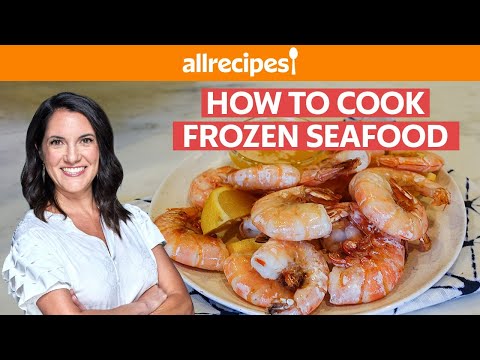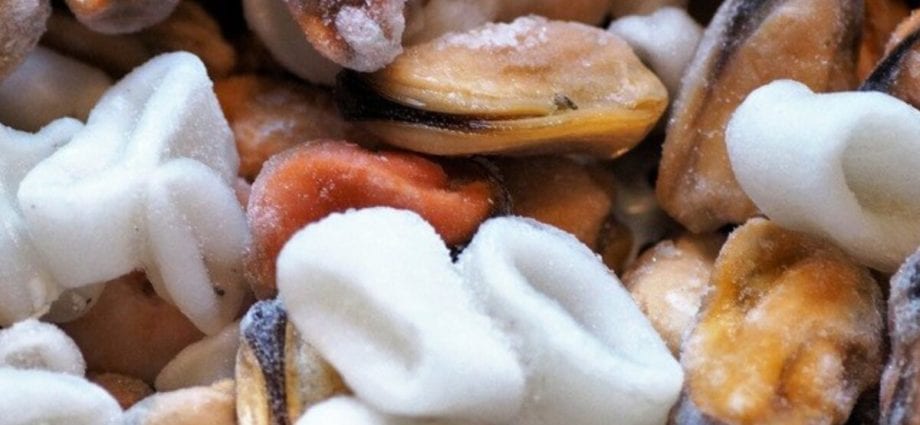Contents
Do you like seafood? I’m sure you love it: it’s hard to find someone who doesn’t like grilled shrimp, brown scallops or mussels in a flavorful sauce. I would eat them every day, if not for one thing: in most regions of our country, seafood is a luxury, moreover, it is available mainly in frozen form.
There are companies in large cities that sell fresh seafood, but this does not change the overall picture. The spice is also added by the fact that it is useless for most of us to learn how to cook seafood from mothers and grandmothers for their lack of such experience. Well, let’s figure it out on our own.
General rules
Fresh seafood is better than frozen, but frozen isn’t necessarily worse than fresh. Paradox? Not at all. Indeed, nothing beats freshly caught sea creeps, especially if you cook and eat them right in the sea, on a boat swaying on the waves. But this luxury, alas, is not available to everyone (more precisely, to almost anyone).
Chilled ones, no matter how quickly they were transported and how carefully they did not control the temperature, they begin to lose quality – and those seafood that was frozen immediately after the catch is seen not only as a more affordable, but sometimes even better quality alternative. Therefore, rule number one: frozen seafood should not be afraid.
In general, two types of seafood can be distinguished: raw-frozen and boiled-frozen, how they differ, I think, is clear from the name. But not for everyone: some tend to boil what has already been boiled, and then chew the rubber, into which the sea protein inevitably turns from excessive heat treatment. There is no need to do this – boiled-frozen seafood can be eaten immediately after defrosting, the maximum is to cook just enough to warm them to the desired temperature, and not for a minute more.
Other things being equal, I always prefer to buy fresh-frozen ones – they, unlike those already boiled, can be prepared in any way at your discretion. Including eating it raw, that is, in the form of carpaccio, ceviche or tartare: deep freezing is almost the only way to guaranteed to kill all parasites, so you can not be afraid for thawed seafood in this regard.
Another general rule is that frozen seafood must either be defrosted as delicately as possible, or start cooking without defrosting at all. In the first case, it is worth transferring the seafood from the freezer to the refrigerator a day before cooking, so that they can thaw calmly without losing their juiciness and texture. At the same time, some juices will inevitably flow out, but it is not necessary to pour them out – they contain the taste of seafood, so you can use these juices when making soup or sauce.
In the second case, you are required to warm up the oil in which you are going to fry seafood as much as possible, and fry them in small portions so as not to cool the pan, as a result of which the worst thing – the loss of its juices by seafood and immediate transformation into rubber – is inevitable.
Squid, shrimps, octopuses, mussels, cuttlefish are popular seafood that are suitable for a festive and everyday menu. They contain a protein that is easily absorbed by the body, they are rich in iodine, vitamin B 12, cobalt, chromium, zinc, selenium. To cook delicious frozen seafood at home, a few simple tips will come in handy.
Variety of sea cocktail flavors
The most affordable option in terms of price and cooking methods is considered by the hostess sea cocktail . It includes squid and octopus tentacles, squid rings, peeled mussels and shrimp, and sometimes cuttlefish meat. This assortment looks beautiful in salads, appetizers, paella and pasta with seafood. But the question arises about the cooking time. Indeed, different seafood is collected in one package, respectively, and they should be prepared in different ways.
The secret is that for the production of a sea cocktail, products that are approximately the same in size and cooking time are selected:
- small shrimp cook for 3-5 minutes;
- squid rings – 3 minutes;
- small octopus tentacles – 3 minutes;
- mussels – 2 minutes.
How and how much to cook seafood
It takes no more than 4-5 minutes to preserve the beneficial properties and deliciously cook the sea platter. A long heat treatment process will turn the delicate tentacles of octopuses and squids into “rubber”.
Cooking Tips:
- 2 servings of water are required to brew a serving of a frozen cocktail. For example, for 1 kg of seafood you need 2 liters of boiling water;
- the semi-finished product should not be thawed before cooking, so that the composition does not lose its shape;
- it is desirable to lower the frozen product into boiling water, salted at the rate of ½ tsp. salt per 1 liter of water;
- for flavor, you can add a bay leaf, a few peas of allspice and black pepper, a sprig of dill, thyme or rosemary to the broth.
On a note. If it happened that the cooking process dragged on longer than 5 minutes, then it must be extended to 20 minutes. During this time, the tentacles of octopuses and squids will become soft again.
How to marinate frozen seafood
A quick way to marinate a sea cocktail allows you to get the basis for a delicious appetizer or salad at home. Marinated seafood is stored in the refrigerator in a tightly closed glass jar for no longer than 1 month, after opening the lid – consumed within 3-4 days.
Cooking method:
- a package of a sea cocktail weighing 1 kg is boiled until tender;
- in a bowl, mix salt, sugar and sunflower oil, 1 tbsp each. l., add a pinch of ground black pepper and 1 tsp. 9% table vinegar;
- seafood is thrown into a colander, allowed to drain excess water, then mixed with marinade and laid out in jars with screw lids;
- when the mixture has cooled, close and put in the refrigerator.
How to fry frozen seafood
Before frying, the mixture is thawed and excess water is removed. Fry over medium heat for 4-5 minutes, using a non-stick or cast iron pan and vegetable oil without a strong odor. First, a clove of garlic with a sprig of rosemary or thyme is fried in oil for 1 minute, after which they are taken out and a sea cocktail is brought to readiness in fragrant oil. Season with salt at the end of cooking.
Shrimps, mussels, octopuses, squids are quick to cook. Their regular use saturates the body with useful vitamins and minerals, replenishes strength and satisfies the feeling of hunger. These products are able to diversify the daily menu and surprise loved ones with delicious dishes.


Watch this video on YouTube
How to cook…
Having said the necessary, but general words, let’s move on to special cases, and consider how to cook frozen mussels, shrimp, scallops and other marine life.
… frozen shrimp
Shrimp is a good example of how common exceptions to the rule are. Firstly, unlike other seafood, shrimps can be quickly defrosted by pouring cold water – they will not lose much juice. Second, shrimp heads contain enzymes that trigger the autolysis process that destroys their meat, so frozen shrimp are often better than chilled ones.
So what do you need to know about frozen shrimp? They are boiled-frozen (red) and raw-frozen (gray, but not always), large and small, with or without a head. Most often, shrimp is fried or boiled. For frying, it is better to take large raw-frozen shrimps and gently defrost them, for cooking, both boiled-frozen and raw-frozen are suitable.
In the first case, it is no longer necessary to re-boil the shrimp, it is enough just to throw it in boiling water for a couple of minutes to heat it up. You can do this without defrosting, but if you have time, I advise you to defrost the shrimp so that they do not cool the water in which they will cook so much.
… frozen mussels
Like shrimp, frozen mussels are found in a variety of configurations – boiled and raw, with or without shells. The most common are boiled-frozen mussels without shells, which are codenamed “mussel meat”. They can be delicately thawed, then eaten straight like that, used in a salad or quickly simmered in some kind of sauce.
Mussels with a shell are already much more interesting: large mussels on one flap are ideal for baking under a golden brown crust, while mussels in a full-fledged shell can be added without defrosting (or half defrosted) into a large saucepan, where the hot sauce is already ready. With freshly frozen mussels, it is worth doing the same, except that you give them a little more time so that they not only heat up, but also cook.
… frozen squid
Squid is perhaps the cheapest sea protein, and with minimal effort it is also tasty and healthy. To properly defrost the squid, transfer it to the refrigerator a day before cooking, then peel the skin (if any), and remove the transparent plates from the inside of the squid, replacing its skeleton. After this thawed squid can be grilled (for these purposes it is best to take smaller squid, squid tentacles will also work), quickly fry in oil, boil or bake. When cooking squid, the main thing is to cook it either very quickly (up to 5 minutes) or long enough (more than 40 minutes), otherwise it will turn out tough.
… frozen scallops
Scallops – it does not matter, only meat or together with the sink – must be defrosted as delicately as possible. For scallops, there is one trick that is said to preserve the maximum amount of juices inside: pour cold milk over the scallops and leave them in it until they are completely defrosted. I do not recommend cooking scallops directly from the freezer: although this is also an option, the surface of thawed scallops, it seems to me, is more susceptible to the formation of a golden brown crust, which means that it will be easier and more habitual for you to assess their readiness and find the right moment to remove the scallops from the heat …
… frozen seafood cocktail
In general, a seafood cocktail is a mixture of various seafood, which usually includes squid, mussels and shrimp (in fact, the composition can be anything: sometimes I add octopuses to this trinity, less often other seafood, as this increases the cost of the cocktail), is a controversial idea. Different seafood requires different times and often different cooking methods. However, frozen seafood cocktails can be made deliciously.
To do this, you need to either defrost it and drain the liquid, or fry it directly in frozen form in hot oil flavored with garlic. In the first case, fry the cocktail over high heat, stirring for 2-3 minutes, in the second, focus on the liquid, which should completely evaporate. Of course, you cannot overload the pan, otherwise it will cool down, the seafood cocktail will not start to fry, but stew, and the seafood will become rubbery as a result.


Watch this video on YouTube










